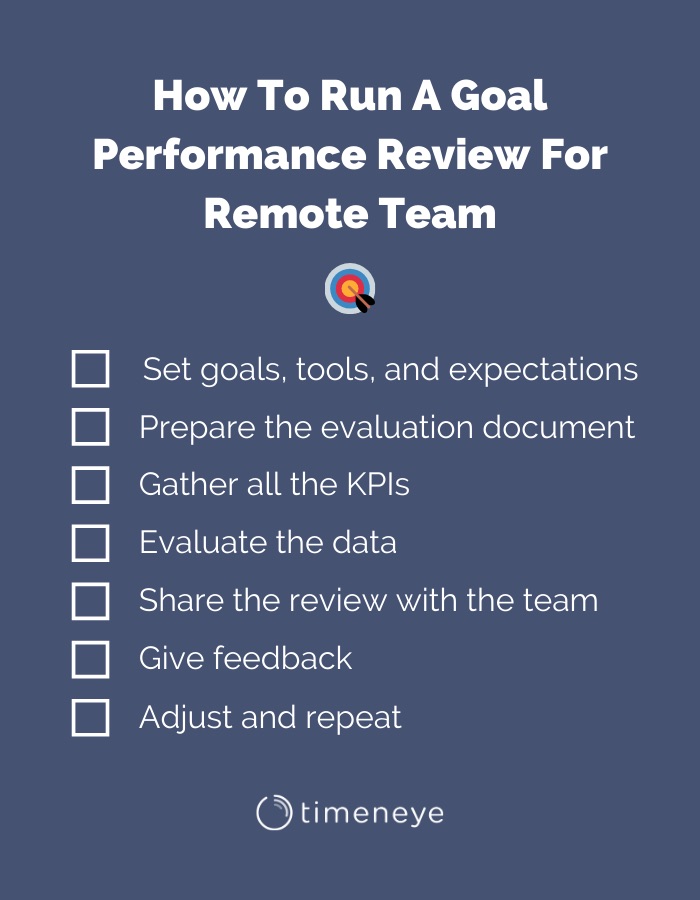Remote teams working together in harmony achieve great goals.
At some point, in order to assess how the team’s doing, team leaders and managers have to evaluate their performance against the team goals.
How is it possible to evaluate a team without any in-person interaction? Managing a remote team is hard, and so is evaluating the work.
In this article, we’ll outline the steps of a performance review in a remote setting - so that teams can find ways to improve work and productivity. Let’s dive in!

But what’s a goal performance review anyway?
Simply put, it’s an evaluation of the team’s performance based on set goals.
Performance reviews are used to measure productivity and improve processes both at a team and at an individual level.
Let’s be honest: nobody likes to be evaluated, and in a work setting, that can be a source of stress. But still, managers have the thankless task of doing the evaluation to understand what’s working and what’s not.
Remote teams need these evaluations to keep everybody aligned with the company goals while being scattered all around the globe.
How to run an effective performance review, from the beginning
Believe it or not, the biggest part of the work is done before the actual review takes place.
Step 0: Things to do before you start
1. Set Goals
First, create goals for the team. You may find that this is probably the most difficult part, because contrary to popular belief, “any goal” just won’t be enough. You have to make sure the goals you set are achievable (so you don’t set your team up to fail!) and aligned with the company goals (otherwise, it’ll be just a waste of time).
To make sure you do that, you can use the SMART goal framework or the OKRs methodology:
S.M.A.R.T. goals: the S.M.A.R.T. framework defines goals as Specific, Measurable, Achievable, Relevant and Time-bound. Assign these 5 criteria to your goals to track progress more effectively. It’s a generic yet useful way of setting goals, both team and personal.
OKRs: OKRs stands for “Objectives and Key Results” and it can be considered as an evolution of the S.M.A.R.T. goals, seen within the company context and in relation with each other. The objectives are the main goals that need to be achieved, while the key results are the metrics to keep an eye on to make sure the objective is within reach.
Whether you use OKRs or S.M.A.R.T. goals, make sure to set the goals and share them with your team.
2. Use the right tools to track
Keep everybody on the same page by using a goal tracker software. Since you and your team cannot meet in person, you’ll need an online tool that’s easy for employees to access, and for managers to use for reporting.
For example, our team is currently using Koan, because it allows us to 1) see all the goals in one place 2) update our progress 3) publish “Weekly reflections” where we can share our achievements and concerns with the rest of the team.
When everything is remote you cannot rely on office papers and in-person interactions to monitor the work, but you can rely on technology in the form of:
- Goals tracking software (as mentioned above);
- Chat software;
- Project management software;
- File sharing for documents;
- Time management tools
..and so on.
Use all these tools to organize the work and keep the team on the same page.
3. Explain the “Why”
Your team members must be aware of how and why their performance has to be evaluated.
Although it’s true that it can create pressure, setting goals and expecting them to be met will encourage a much more result-oriented mindset for the team.
Communication within a remote team is already difficult due to the physical distance, technical issues, and time zone differences.
The clearer are your expectations and assignments, the better.

Step 1: Prepare your evaluation document
It’s a good idea to keep everything in written form. This way you’ll have all the historic data of the evaluations available for both you and the team.
You don’t have to create extensive documents or complicated reports.
The team at Quantum Workplace has created many performance review templates for you to check out. You can use one of them or build your own.
Step 2: Gather all the data you need
Thanks to the online tools you've been using as explained above, you shouldn’t have trouble gathering the data you need.
Make sure to select a specific time frame for reference.
The time frame you use must be reasonable enough for the team to reach the goals, but not so wide that too many variables are taken into account and affect the outcome.
Step 3: Evaluate the data
Check all the metrics and see how they have progressed. Don’t forget to take a look at all the notes and comments from your employees. By the end of it you should be able to answer these questions:
- Were the objectives reached? Why / why not?
- Were there issues (team-wide or otherwise)? Why / why not?
- Which metrics have been improved? Why? How?
Step 4: Share the review with the team
Obviously, you won’t be able to hold the meeting in person because you’ll probably be separated. (Unless, of course, you’re planning a company meetup).
But that’s not a problem! When it’s time to talk to your team members about their evaluation, set up a virtual meeting by creating an event in a shared team calendar.
Make sure you’re using the appropriate technology and tools so that the meeting goes smoothly (and you avoid awkward moments of silence…).
It’s important that this meeting be really a conversation.
Let your employees, too, speak and ask them their input on how the work went and what things can be changed or improved.
You and your team don’t experience the work at the same pace - and not even in the same place!
This is why you have to constantly communicate with the team to get their insights and hear in their own voice how their work is going.
That doesn’t mean passing on the burden of a decision to the team. You’ll still be the one conducting the evaluation, but without their input, you won’t have the whole picture.
Step 5: Give feedback
So, how did your team members fare? Let them know!
When giving out feedback, always remember to be constructive. May it be to point out merits or flaws, all the parties involved must understand that the evaluation benefits the whole team.
Your feedback should also include tips on self-development for the team members so that they can improve their performance on a productive and personal level.
Step 6: Adjust and repeat
Every evaluation you run will give you new insights and tips on how to improve not only the team’s performance, but also the review process as well.
(This is why you should always keep a written track of the evaluations you run.)
Now take some time to refine, adjust, and even change your methodology if necessary, and you’ll see all the processes run like well-oiled machines.

Conclusion
Evaluation of remote workers is different because there is no daily personal interaction with the team.
Leaders and team members should not shy away from evaluations if they want to achieve their goals, improve productivity, and work better.
With shared goals, clear communication, and the right tools, the process will work like a clock!
About the author:
Stefania Rossi, is the Marketing Manager of Timeneye, a time tracking software for small businesses. She's passionate about productivity and technology and she's an author for the Timeneye Blog. When she's not writing for the blog, she's probably somewhere reading a book.
What would you like to know and what would be the best way to share this information to you? What is the best tips & tricks, what workaround do you use? We'd really appreciate your insight on these ones to make our integrations better, more productive and much more efficient. Comments, tweets are always welcome.